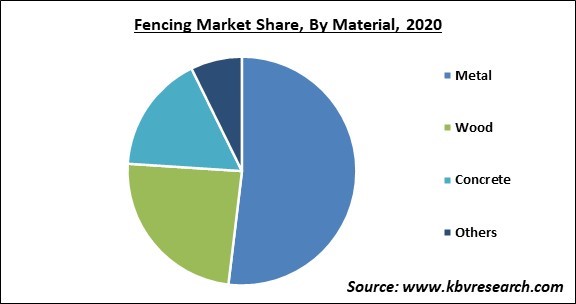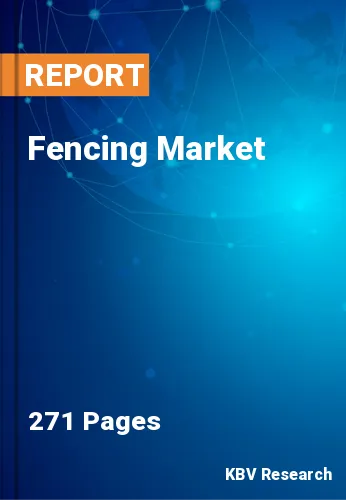The Global Fencing Market size is expected to reach $37.6 billion by 2027, rising at a market growth of 4.8% CAGR during the forecast period.
Fencing is the technique of enclosing any asset that needs security and protection from unauthorized access. Fences are used to give security to agricultural, commercial, and residential structures. In addition, fences are classified into two types: commercial wire fence and agricultural wire fence. Commercial wire fence is typically used for the security of parks, residential buildings, and other structures, whilst agricultural wire fencing is commonly utilized for the security of animals. Metal, composites, plastic, and wood are the most common materials used to construct fences. The major goal of building fences is to guarantee that no trespassers or undesired items access the guarded property, as well as to keep livestock from escaping the area given.
As a result of the increased need to improve the look and value of a home, fencing products are projected to showcase an increase in demand. The market is expected to be driven by increased expenditure on institutional buildings, rising government investment on improving parks, government facilities, and public spaces.

The outbreak of the COVID-19 pandemic has negatively impacted various domains of the business world. The imposition of numerous restrictions like complete or partial lockdown, ban on manufacturing units, social distancing rule and many more has made it more difficult for the companies to survive during these crises.
Travel restrictions across the world have had an impact on the building materials sector. As a result, the supply and demand for construction materials has come to a standstill. Construction material production enterprises in China are most affected by the pandemic, due to the region's lockdown and lack of supplies.
With the expansion in the population around the world, the demand for various facilities like schools, buildings, industries, government building and office has increased in the last few years. In addition, people and companies across different verticals are highly investing in making their home more beautiful and attractive along with ensuring the safety of their homes. The construction sector has traditionally been one of the most revenue-generating industries on a large scale. Recently, there has been an increase in the demand for independent residences and new building methods.
Every market is being impacted by technological innovation and advancement. Traditional agricultural fence systems need a lot of labour and supervision. When compared to conventional techniques and technologies, newer approaches have shown to be equally successful. For example, virtual fence is a recent development in the fencing sector. This kind of fencing is a technology in which a real and physical fence is not employed; instead, it operates on the basis of a GPS monitoring system and induces a stimulus into the animal's body via a neck band when such animal attempts to leave the specified area.
The huge cost attached to the up gradation and maintenance involved with replacing traditional electric fence is impeding industry expansion. The high maintenance expense is due to the obligation to install barriers across international boundaries and conduct frequent inspection to ensure optimal utilization. End-users are exploring other alternatives, such as unmanned systems, due to the high maintenance costs, which would hinder the growth of the fencing market.
In order to improve the security of a place or facility, people install better fencing system that incurs more expense than ordinary fencing. One significant factor affecting the market is the increased demand for environmentally friendly fencing.

Based on Installation, the market is segmented into Contractor and Do-It-Yourself. The contractor segment dominated the fencing market. It is because many contractors provide experience-based gate and other product placement, as well as design advice, which motivate consumers to opt for this kind of installation.
Based on End Use, the market is segmented into Military & Defence, Petroleum & Chemicals, Transport, Government, Energy & Power, Mining, and Others. The petroleum & chemical segment garnered a substantial revenue share in the fencing market in 2020 and is estimated to maintain this trend over the forecast period. Petroleum and chemical plants require the strict safeguards to avoid explosions and tragedies. The risk of hazardous poisons, explosive chemicals, and caustic gases is quite significant in the petroleum industry, leading to a rise in the building of fence around its limits. Many companies are opting for fence that is both physically deterrent and aesthetically appealing.
Based on Application, the market is segmented into Residential, Agricultural and Industrial. The agricultural segment garnered a significant revenue share in fencing market in 2020. The increased need to protect farm animals, crops, and farm lands from wild animals and thieves is expected to fuel product demand in agricultural sector. Moreover, an increase in incursion activities such as raiding a farm's chemical storage and stealing valuable pesticides promotes need for agricultural fence. Fences used in agricultural sector are developed and constructed in accordance with client specifications using high-quality raw materials.
Based on Distribution Channel, the market is segmented into Retail and Online. The retail distribution channel segment garnered the maximum revenue share. Customers get immediate access to the items given by major vendors through retail outlets. Moreover, the retail distribution channel enables businesses to lower their marketing spend.
Based on Material, the market is segmented into Metal, Wood, Concrete and Others. The wood segment procured a significant revenue share. Due to its natural look, wood fence is a preferred for residential sector. Additionally, owing to the lower costs, wood may face significant competition from plastic and composite throughout the forecast period.
| Report Attribute | Details |
|---|---|
| Market size value in 2020 | USD 27.7 Billion |
| Market size forecast in 2027 | USD 37.6 Billion |
| Base Year | 2020 |
| Historical Period | 2017 to 2019 |
| Forecast Period | 2021 to 2027 |
| Revenue Growth Rate | CAGR of 4.8% from 2021 to 2027 |
| Number of Pages | 271 |
| Number of Tables | 559 |
| Report coverage | Market Trends, Revenue Estimation and Forecast, Segmentation Analysis, Regional and Country Breakdown, Companies Strategic Developments, Company Profiling |
| Segments covered | Installation, End Use, Application, Distribution Channel, Material, Region |
| Country scope | US, Canada, Mexico, Germany, UK, France, Russia, Spain, Italy, China, Japan, India, South Korea, Singapore, Malaysia, Brazil, Argentina, UAE, Saudi Arabia, South Africa, Nigeria |
| Growth Drivers |
|
| Restraints |
|
Based on Regions, the market is segmented into North America, Europe, Asia Pacific, and Latin America, Middle East & Africa. North America emerged as the leading region in the fencing market with the maximum revenue share in 2020 and is anticipated to continue this trend over the forecast period. Rising growth in construction activities and demand for elegant home products are projected to account for the regional market growth.
Free Valuable Insights: Global Fencing Market size to reach USD 37.6 Billion by 2027
The market research report covers the analysis of key stake holders of the market. Key companies profiled in the report include Saint-Gobain Group (CertainTeed), Allied Tube & Conduit (Atkore, Inc.), Ameristar Perimeter Security (ASSA ABLOY), N.V. Bekaert S.A., Betafence Group, Gregory Industries, Inc., Long Fence, Inc., Ply Gem Industries, Inc., and Poly Vinyl Creations, Inc.
By Installation
By End Use
By Application
By Distribution Channel
By Material
By Geography
The fencing market size is projected to reach USD 37.6 billion by 2027.
Expansion of the construction industry are driving the market in coming years, however, the introduction of new technologies limited the growth of the market.
Saint-Gobain Group (CertainTeed), Allied Tube & Conduit (Atkore, Inc.), Ameristar Perimeter Security (ASSA ABLOY), N.V. Bekaert S.A., Betafence Group, Gregory Industries, Inc., Long Fence, Inc., Ply Gem Industries, Inc., and Poly Vinyl Creations, Inc.
The Do-It-Yourself segment shows high growth rate of 8.2% during (2021 - 2027). Several Do-It-Yourself (DIY) kits are available in various retail stores.
The Military & Defense market is leading the Global Fencing Market by End Use 2020, and would continue to be a dominant market till 2027; thereby, achieving a market value of $9.8 billion by 2027.
The North America market dominated the Global Fencing Market by Region 2020, and would continue to be a dominant market till 2027; thereby, achieving a market value of $12.7 billion by 2027.
Our team of dedicated experts can provide you with attractive expansion opportunities for your business.

